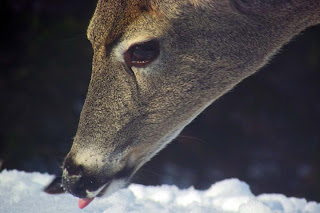In North America, the species is widely distributed east of the Rocky Mountains, but elsewhere, it is mostly replaced by the black-tailed or mule deer
The white-tailed deer species has tremendous genetic variation and is adaptable to several environments
The deer's coat is a reddish-brown in the spring and summer and turns to a grey-brown throughout the fall and winter. The deer can be recognized by the characteristic white underside to its tail, which it shows as a signal of alarm by raising the tail during escape.
North American male deer (also known as a buck or stag) usually weighs 60 to 130 kg (130 to 290 lb) but, in rare cases, bucks in excess of 159 kg (350 lb) have been recorded. Mature bucks over 400 pounds are recorded in the northernmost reaches of their native range, specifically, Minnesota and Ontario. The female (doe) in North America usually weighs from 40 to 90 kg (88 to 200 lb).
Deer have dichromatic (two-color) vision with blue and yellow primaries; humans have trichromatic vision. Thus deer poorly distinguish the oranges and reds that stand out so well to humans. This makes it very convenient to use deer-hunter orange as a safety colour on caps and clothing to avoid accidental shootings during hunting seasons.
Males re-grow their antlers every year. About 1 in 10,000 females also have antlers, although this is usually associated with hermaphroditism. Bucks without branching antlers are often termed "Spikehorn", "spiked bucks", "spike bucks" or simply "spike". The spikes can be quite long or very short. Length and branching of antlers is determined by nutrition, age, and genetics. Rack growth tends to be very important from late spring till about a month before velvet sheds. During this time frame damage that may be done to the racks tends to be permanent. Healthy deer in some areas that are well fed can have eight-point branching antlers as yearlings (one and a half years old). The number of points, the length or thickness of the antlers are a general indication of age but cannot be relied upon for positive aging. A better indication of age is the length of the snout and the color of the coat, with older deer tending to have longer snouts and grayer coats.
White-tailed deer are generalists and can adapt to a wide variety of habitats. Although, most often thought of as forest animals depending on relatively small openings and edges, white-tailed deer can equally adapt themselves to life in more open prairie, savanna woodlands, and sage communities as in the Southwestern United States and northern Mexico.
Whitetail deer eat large varieties of food, commonly eating legumes and foraging on other plants, including shoots, leaves, cacti, and grasses. They also eat acorns, fruit, and corn. Their special stomach allows them to eat some things that humans cannot, such as mushrooms and poison ivy. Their diet varies by season according to availability of food sources. They will also eat hay, grass, white clover, and other food that they can find in a farm yard. Though almost entirely herbivorous, white-tailed deer have been known to opportunistically feed on nesting songbirds, field mice, and birds.
White-tailed deer communicate in many different ways using sounds, scent, body language, and marking. All white-tailed deer are capable of producing audible noises unique to each animal. Fawns release a high-pitched squeal, known as a bleat, to call out to their mothers. A doe makes maternal grunts when searching for her bedded fawns. Grunting produces a low, guttural sound that will attract the attention of any other deer in the area. Both does and bucks snort, a sound that often signals danger.
Whitetail deer can live up to 10 years in the wild and 20 years in captivity.












Years ago, I grew up in Wisconsin. My first encounter with a whitetail was a mutual surprise: a loud huffy snort and the white flag
ReplyDeletetail-both of us running in opposite directions.
In a canoe, they can be approached in the wild within a few feet, if you drift silently up to them. The woodland deer were a shade of gray,
the tamarack swamp whitetails, a russet red.
I was not a hunter, but appreciated these silent
forest herbivores for their beauty, graceful leap and link to the pre-settlement past.